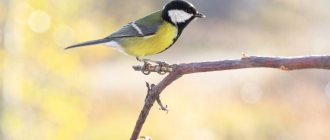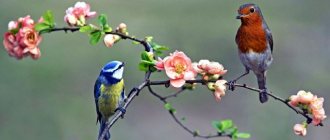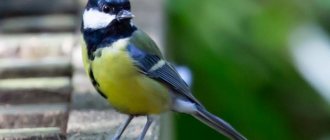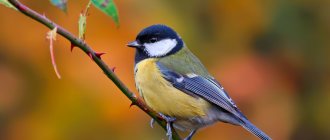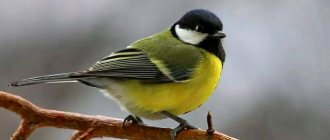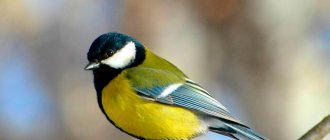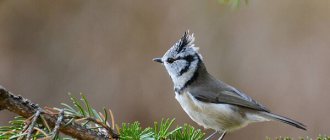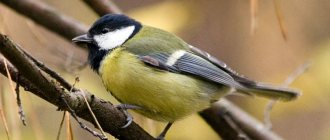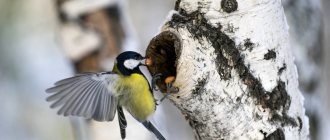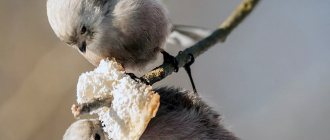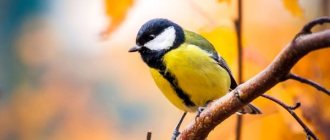Appearance and description
It is customary to call tits only those birds that belong to the tit family. The most common species in Russia is the great tit (Parus major).
Appearance of a tit
Appearance of a tit
Appearance of a tit
Appearance of a tit
Birds belonging to the order of song passerines, for the most part, differ from ordinary sparrows in being slightly larger in size and having an elongated tail. Their breast is lighter than the rest of the plumage, most often yellow, gray or beige. The beak is sharp and short, the head has a contrasting cap or crest, as well as prominent light cheeks.
The blue color of feathers, oddly enough, is not inherent in all tits. However, in some species, dark blue tones are present in the color of the feather cover of the back, cap, and flight and tail feathers.
Gaichka
Brown-headed tit, puffy tit, marsh tit - all these are names of a numerous and medium-sized species of tits. It is distinguished by a rather unremarkable color, devoid of variegated tones. The head, occipital part and a small spot under the beak are rich black. The entire upper part of the body is painted in light gray tones, and the chest, abdomen and cheeks are almost white. The tail and wings are darker - from gray to brown.
You can meet the chickadee almost everywhere: from Pskov to Kharkov and Voronezh, as well as from the Volga region to the Pacific Ocean. Caucasian, Altai and Siberian marsh tits are being replaced by geographical subspecies, most similar to the common tit. Chickadees nest in hollows that they hollow out themselves, but sometimes they are capable of occupying a ready-made home.
Habitat - where it lives
Habitat of the tit
The most common species, the great tit, lives in vast areas of Eurasia and the very north of Africa. Other species of the family can be found across three continents: Eurasia, Africa and North America, as well as in the territories of the Japanese and Malay archipelagos.
Interesting fact : Birds of the tit family are not found in South America and Australia.
Tits mainly prefer to settle in deciduous forests, choosing to build nests on the outskirts of open places such as clearings and forest edges. In addition, they are not afraid to live next door to people and feel great in personal plots, gardens, city squares and forested areas.
Polovnik
Among the different species of tits, one can especially note the long-tailed beautiful tit. It differs from all other varieties by its long tail and small body size. The silhouette of this titmouse resembles a spoon. The very beautiful plumage of the polovnik consists of loose and light feathers. The head, neck and chest of this bird are white or slightly grayish. The sides and top of the tail have a pink-wine tint, and the rump, shoulders, wings and tail itself are searing black. In addition, the outer edges of the fans are white, which widens from the middle.
In general, the long-tailed tit is considered a rare bird. However, in our country they are especially common. The titmouse is one of the most common species of tits in the Tula region, the Caucasus, Crimea and the Ussuri region. They especially love damp deciduous forests.
Interestingly, the titmouse is one of the few tits that can be tamed and can live in captivity for a long time. The trusting bird is able to eat from the hand within 3-4 days after being caught. The main condition for its maintenance is the availability of a variety of food. In addition, the long-tailed tit sings loudly and melodiously, and therefore is especially valued among both beginners and experienced birders. It is best to keep it together with a canary, which will teach the titmouse to sing more beautifully.
Character and lifestyle
Birds of the tit family are distinguished by their incredible mobility and activity. However, despite the fact that it is difficult for birds in constant flight to hide in one place, they are absolutely unpretentious in terms of choosing their habitat. In addition, tits are very dexterous birds and, due to their tenacious and strong legs, are capable of performing real gymnastic tricks, including various somersaults.
It is thanks to the strength and development of their paws that they can survive in adverse weather, even without being able to hide in the nest. In such situations, the birds cling to a branch with their claws, shrink into a small fluffy ball and quickly fall asleep. This ability makes life much easier during periods of severe frost.
Most representatives of the tit family lead a sedentary lifestyle. However, there are also some species of these birds that can migrate from time to time. There are also exceptions to the typical pair existence. For example, gray tits sometimes form small groups or join mixed flocks with other birds to more efficiently forage during times of famine.
Interesting: Birds of Moscow and the Moscow region: list, types, photos, names, videos, descriptions, features
Characteristics and behavior of tits: description for children
Tits most often appear to us as active, fast, restless birds, and this is what they really are.
- The hanging titmouse is a very quiet bird that always behaves neatly and silently. Despite this, she is very dexterous in her movements: she can very quickly and quietly inspect tree branches and flowers, in which she looks for bugs for food.
- The long-tailed tit is very sociable and is rarely very afraid of people, so very often you can find such a bird living in someone’s house. Apollonovka differs from many other birds in that it can sing very beautifully. That is why poultry farmers who want to teach other birds to sing take the long-tailed tit as a teacher.
Titmouse
- Blue tits are frisky, active birds that love to jump from branch to branch, while hanging from the branch upside down from time to time. This titmouse is not very afraid of people, so it can often be seen near residential buildings. By nature, the blue tit is not a very good flyer, but uses its legs to move very quickly. This bird can also be called curious, as it loves to “stick its nose” into any crack or hole in the tree.
- The great tit is a very fast, mobile bird. Loves to jump on branches, hanging upside down from them. The great tit flies well, but in order to fly, it flaps its wings frequently. Most often, such a bird can be seen in a flock with other tits.
- The Muscovite is a restless bird that will never sit in one place for a long time. The titmouse flies quickly and well, and while searching for food it also hangs upside down by branches.
- The tufted tit also boasts of its activity and restlessness. Most often it can be seen in the crown of trees, where the bird hides from prying eyes.
As you can see, all titmice are very mobile and active birds, which rarely just sit on tree branches.
What does it eat?
Tits love lard
Tits of all types are insectivorous birds, and they can be called real orderlies of nature. These birds, destroying countless harmful insects and their larvae, save entire forests and cultural plantings from destruction. Thus, a pair of tits feeding their offspring can completely rid more than forty trees of pests.
Interesting fact : it was previously believed that tits were exclusively insectivorous birds. However, recently, ornithological researchers have provided evidence that some species sometimes prey on small bats.
Diet
When these birds actively breed, they eat small invertebrates, including their larvae. These birds, which are considered real forest orderlies, eat a lot of harmful insects. Despite this, the basis of the tit’s diet includes:
- Butterfly caterpillars.
- Spiders.
- Centipedes and other beetles.
- Diptera insects, including flies, mosquitoes and midges.
- Hemipteran living creatures, including bedbugs.
In addition, their diet includes cockroaches, grasshoppers and crickets, as well as small dragonflies, lacewings, earwigs, ants, ticks, millipedes, etc. A tit can also eat a bee after the sting is removed. After wintering, tits hunt bats - dwarfs, which with the arrival of spring are not particularly mobile and become accessible to these orderlies of nature. Tits feed their chicks mainly with butterfly caterpillars, the size of which does not exceed 1 cm.
With the arrival of autumn and then winter, the basis of the tit's diet consists of plant foods, in the form of hazel and Jewish beech seeds. Tits often migrate in search of food, visiting fields where grains of various crops such as corn, rye, oats, wheat and others remain.
In addition to the above food items of plant origin, depending on living conditions, tits feed on the fruits and seeds of the following plants:
- Spruce and pine trees.
- Maple and linden.
- Lilacs.
- Birches.
- Horse sorrel.
- Pikulnikov.
- Lopukhov.
- Red elderberry.
- Irgi.
- Rowan trees.
- Blueberries.
- Hemp and sunflower.
The great tit, unlike some other representatives of this genus, such as the blue tit and the tit, does not store reserves for the winter. The tit is such an agile bird that it easily finds food reserves collected by other birds. Some experts claim that the great tit is capable of eating all kinds of carrion.
Tits often fly into urban areas and visit parks and other places where bird feeders are installed. Here they find seeds, bread crumbs and other food scraps, butter and unsalted pieces of lard. They obtain food for themselves wherever possible, including in the crowns of trees, as well as in the fallen leaves of trees and shrubs.
Interesting information! The great tit is distinguished by the fact that it has a fairly extensive list of food items. She is capable of killing other smaller birds, after which she pecks out their brains.
The great tit has a fairly strong and powerful beak, which the bird uses to break nuts and other fruits with a hard surface before eating the tasty insides. Great tits are also characterized as carnivores, as they are known to feed on the remains of a variety of mammals.
How long does a tit live?
Under natural conditions, tits live on average about three years. However, in captivity, subject to the right conditions, maintenance and feeding, birds can live up to 15 years.
This difference in life expectancy is a consequence not only of the fact that animals receive the necessary care and attention every day at home, but also of their sociability and curiosity. Tits quickly get used to human society, do not experience stress in his presence and willingly make contact.
Tit at home
At home, tits are kept in individual or paired cages. Buy single cells that are spacious (at least 45 centimeters in diameter). To breed a pair, you need to buy several cages - a spacious aviary with a nesting house and two separate cages for breeding conflicting birds.
Food for tits kept at home may include:
- chopped chicken eggs (hard-boiled);
- curd mixtures (with the addition of crushed crackers, grated carrots);
- white bread (preferably moistened with sweetened water or milk);
- dried insect powders (can be purchased at pet stores);
- thickly cooked porridge;
- tree buds;
- ready-made food "Padovan";
- mealybugs;
- shelled pine nuts;
- rowan berries;
- dried fir cones (the bird itself gets the seeds);
- sunflower seeds (preferably sprouted; roasted seeds should not be fed to birds);
- chopped herbs (dandelion, chickweed, tradescantia);
- sprouted grain mixture;
- flour beetle larvae.
The birds are fed in the morning and in the evening, you can determine the dose yourself - there should be a minimum of food left in the feeder. The tit eats slices of cucumbers, apples, boiled meat, and citrus fruits less willingly. The diet must be supplemented with vitamin B1 or multivitamins. The tablets are crushed and dissolved in porridges and curd mixtures. The titmouse quickly becomes tamed and gets used to taking food from hands.
Many species of tits quickly get used to humans and take food from people’s hands.
But there is no need to abuse this. If the bird flies out, don't scare it. Wait until the titmouse gets hungry and flies into the cage. If the bird has lived in the house for several years, brave owners leave the cage open. The titmouse flies throughout the apartment, hunts for mosquitoes, cockroaches, and bugs, quickly clearing the home of them. At the same time, you need to keep the windows and vents closed, as the inquisitive titmouse flies out into the street and may not return. If a titmouse is raised from a chick, it has no one to learn its natural singing from. In this case, the bird begins to imitate an electric kettle, an alarm clock, and the sounds of a smartphone.
In a large aviary you can keep together a chickadee, an Apollo's chickadee, and other representatives of the tit family, with the exception of the great tit. Bolshak does not tolerate competitors and kills smaller birds.
Keeping friendly songbirds in your home will bring you many pleasant moments, but will require constant care. You need to regularly clean the cage, hang dry branches in it, often add fresh water, and monitor the health of the tits.
Reproduction of tits
Tit with chicks
Puberty in tits occurs at the age of 9-10 months. They are monogamous birds, nest in pairs, feed their offspring and defend themselves.
The breeding season for tits occurs in early to mid-spring. However, these birds begin to form pairs in the middle of winter. At this time, you can increasingly hear them chirping, see conflicts between males and courtship with females. Males, showing signs of attention, try to feed the female, showing that they can provide food for both them and the chicks. Tits also demonstrate to each other their abilities in arranging a nest, deftly manipulating twigs. At the end of winter they unite in pairs.
Interesting fact : tits that have already had experience in breeding chicks try to find their old partner, even if they have spent time apart since the last breeding season.
Typically, birds of the tit family make their nests in tree hollows, but sometimes they also use forks of branches, depressions in the ground, birdhouses and various cavities of natural or artificial origin. The construction and arrangement of the nest is most often done by the female, making a frame of flexible twigs, which is lined with moss, feathers, down, wool or found artificial materials to maintain warmth.
A pair of titmice usually hatches from two to six chicks, but cases have been recorded when 14 small birds appeared in one nest. Under the supervision of their parents, the cubs develop over about a month. Even when they begin to fly out of the nest on days 15-22, they remain under the care of adults for another two weeks.
Representatives of the tit family are able to hatch chicks once or twice, and sometimes three times a year. Birds can settle in the same nest or build a new one, but the number of eggs in the clutch decreases each time.
Do they breed in captivity?
Do tits breed in captivity? Photo
If a pair of tits gets along in the same enclosure, then over time the birds can begin nesting, for which they need to leave building material - twigs, blades of grass, moss. In one clutch in nature, a female tit can have up to 15 eggs. In captivity, as a rule, less. The female incubates the eggs for 13 days, and then the chicks grow up for about 3 weeks. All this time the male takes care of his wife and offspring.
Natural enemies
Tits sometimes fight with each other.
Tits in their natural habitat have a large number of enemies. Predators such as kites, eagles, eagle owls, owls, barn owls and golden eagles do not mind feasting on the bird. Woodpeckers also like to destroy their nests.
Interesting fact : even in ancient times, people understood the benefits of tits that exterminate insects. So, back in the 14th century, Louis of Bavaria issued a law protecting birds, according to which a significant fine was imposed for killing a tit.
Squirrels also destroy tits' houses, which is why they have to rebuild them. Fleas, which settle on the body in entire colonies, cause great harm to tits.
Interesting: Monkeys - Species with photos and videos, names, features, description, food, where they live
Bird behavior in the wild
The tit is widespread almost all over the world. It has not taken root only in Central and South America, the Caribbean Islands, Madagascar, Antarctica, Australia, and New Guinea.
Where do they live and spend the winter?
In summer, birds prefer to live in open areas; they settle and build their nests on the edge of deciduous and mixed forests, next to clearings. The habitat depends on the species. Birds living in Europe prefer oak forests, Siberian birds like to settle on the outskirts of the taiga, and in Asian countries they choose semi-desert landscapes.
Titmouse nests are built in the forest-steppe, where there are nearby rivers, ponds or lakes. Birds can also be found in the mountains. They build their nests at an altitude of no higher than 1950 meters above sea level.
With the onset of winter, when there are few insects in the forests, birds fly closer to people. In winter, they spend the night in warmer and windless places, such as:
- hollows in trees;
- cracks in buildings;
- birdhouses;
- free space under the roof.
On a note! To maintain warmth, birds spend the night in flocks, huddled closely together.
Diet
Tits are insectivorous birds. Their summer diet is as follows:
- invertebrates and their larvae;
- caterpillars of butterflies and dragonflies;
- spiders, beetles;
- blood-sucking insects;
- aphids and ants;
- grasshoppers.
In spring, birds are not averse to feasting on dwarf pipistrelle bats, fresh from hibernation.
In the autumn-winter period they feed on:
- hazel;
- grains of corn, sunflower, wheat, oats;
- livestock feed;
- white bread;
- fresh lard;
- berries;
- kidneys;
- sometimes they allow themselves to feast on carrion.
Important! The tit is a forest orderly. In one day, one individual is capable of destroying about 600 insect pests.
Fried seeds and salted lard are prohibited
Reproduction
Tits begin to build nests in early spring and mid-summer. To do this, they use a variety of materials: feathers, cotton wool, cobwebs, branches, fluff and moss. Birds make their nests in tree hollows, between branches, in cracks and holes in buildings at a height of 3-6 meters. A large number of nests can be seen along river banks at a height of 2 meters from the ground. Tits often choose abandoned nests to lay eggs.
During the mating season, they become aggressive, deftly driving away enemies, protecting their home. At one time, the female lays up to 15 eggs. Their surface is white, shiny, with small chocolate-colored spots.
Eggs mature in 13 days. Only females hatch the chicks; males are assigned the role of food providers. The hatched chicks are covered with a small fluff, so the titmouse is constantly in the nest, warming the young with its body.
On a note! Newborn chicks are very voracious. Parents have to feed them up to 40 times an hour.
Growing chicks become independent at 17 days of age. But they do not fly far from their parents. 10 months after birth, the chick reaches sexual maturity and becomes an independent individual.
Types of tits
Types of tits
The tit family (Paridae) currently includes more than 60 species of birds, of which from 9 to 11 (according to various sources) live in Russia. The most common in Russia are seven species of these birds.
Great tit
Great tit
The body of a great tit (great tit) can reach a length of 17 cm, weight - 21 g, and a wingspan of 26 cm. The bird's plumage is brightly colored: on the chest it is yellow, with a black longitudinal stripe in the middle, the head is decorated with a cap, on her contrasting white cheeks stand out. The plumage of the wings and tail is bluish, with clear white stripes, the undertail is dark in color.
Bolshak is found throughout Russia, in most European countries, in the northern regions of Africa and some Asian countries. Great tits prefer to make nests in trees located near forest clearings and on the banks of reservoirs.
Brown-headed Chickadee
Brown-headed chickadee
The body length of the brown-headed chickadee (puffy chickadee) reaches 15 cm, weight – 15 g, wingspan – 22 cm. The color of the bird has no pronounced color spots, it has a gray back and feathers, a black chin and a cap that extends like a wedge onto its back, white breast and cheeks that do not have a demarcation strip.
The brown-headed chickadee is common in forest areas of Eurasia, covering areas of Great Britain and France. Puffy moths most often live in dense coniferous and mixed forests, in places remote from human settlements.
Moskovka
Muscovy
The length of the Muscovy's body is 12 cm, the maximum weight is 12 g, the wingspan is 21 cm. This tit has a light gray belly, back, nape and cheeks. But due to the predominance of dark feathers on the top of the head, shirtfront under the beak and neck, the bird is often called a black tit. Some representatives of this species have a prominent crest on the top of their head.
Muscovites live in forested areas of Eurasia throughout the continent, from west to east. And in southern latitudes they are found even in some areas of Africa, India and China. They prefer to settle in pine needles, but can move to mixed forests and even to orchards.
Tufted tit
Tufted Tit
The body of the Tufted Tit (Grenadier) reaches 14 cm, weight - 14 g, wingspan - 22 cm. This bird received its name because of the sharp striped crest on its head. The tit's back is grayish-brown, and its belly is gray-beige. There is a distinctive black necklace on the neck, a stripe also outlines the cheeks and marks the area between the beak and the chest.
The grenadier is common in most European countries, throughout the European part of Russia and in the south of the Urals. Tufted tits usually choose coniferous forests as habitats, but in some cases they can settle in mixed forests.
Blue Tit
The common
blue tit has a body length of no more than 12 cm, a maximum weight of 14.7 g, its wingspan can reach 20 cm. The bird is distinguished by the blue color of the feathers on the wings and tail, which are bordered by black and white stripes. The white head of the blue tit is covered with a blue cap, the neck is outlined with a dark blue line. Also, a vertical stripe runs through the tit's yellow-green abdomen.
The habitat of the common blue tit is the subtropical, temperate and subarctic zones of Europe, Asia and Africa. These tits prefer to nest in mixed forests with a predominance of birch and oak trees.
Swamp chickadee
Swamp chickadee
The body length of the swamp chickadee can reach 14 cm, weight – 15 g, and the width of the wingspan – 20 cm. The bird is also called black-headed for the dark cap “dressed” on its head. The belly and back are gray-beige, the collar and cheeks are lighter in color, and there is a black spot under the beak. The feathers of the wings and tail are brown.
Interesting: Migratory birds: list, names, descriptions, types, characteristics, photos and videos
This type of chickadee is widespread throughout Europe, Eastern Siberia, China and Asia Minor. For living, he prefers to choose deciduous and mixed forests, as well as gardens and parks.
Blue Tit
White blue tit
The length of the body of the white blue tit (princeling) rarely exceeds 15 cm, weight - 16 g, and the largest individuals have a wingspan of 22 cm. The abdomen, chest, cap and neck are white, gray-blue at the back, dark blue flight feathers and tail feathers with a white border along the edges and a transverse stripe.
The habitats of the blue tit are Southern Siberia, Central Asia, and the regions of Eurasia located east of Belarus. The princeling prefers to settle in deciduous and mixed floodplain forests, reed swamps, orchards and forest parks.
Moskovka
This species of tit is also called black or little tit. Its size is approximately one and a half to two times smaller than that of the great tit, and its color scheme almost completely coincides with it. The Muscovy has shiny black the following parts of the body: throat, neck, forehead, top and back of the head, and stripes on the sides of the back of the neck. The cheeks and side of the neck are snow-white. The wings and tail are dark gray, and the breast and abdomen are slightly reddish. Among all types of tits, this one is the most tame and trusting.
The habitat of the Muscovy is a fairly vast territory: from Lapland to Ukraine, and in Russia - almost throughout the taiga, Ryazan and Ulyanovsk. Crimean, Caucasian and Tien Shan Muscovites are distinguished by the presence of brown or olive plumage on the abdomen, as well as stronger beaks.
How do tits winter?
The tit looks for food in winter.
In winter, before the coldest hours of the night, tits flock into small flocks, look for shelter and huddle there into a single fluffy ball. This type of overnight stay helps birds keep warm and not freeze even in the most severe frosts.
Interesting fact : Tits are non-migratory birds; they are noticed mostly in winter, because in summer there is enough food in the forest. With the onset of cold weather, they move closer to people.
The vast majority of tits are nomadic birds, changing their habitat in search of a food supply that can provide them with a “well-fed” life.
Is it possible and how to feed tits with lard, fried and raw seeds, and millet?
If we talk about feeding these birds by people, then seeds, millet and lard are the main products of their diet. However, this does not mean that you just need to throw these foods out the window and be happy for your good deed and for the tits that they have something to eat. If you want to do a good deed, do it right.
- Under no circumstances should you give salted lard to tits, as it can cause problems with the gastrointestinal tract and even lead to death. Moreover, think logically, there are no salty foods in nature for tits, that is, their body is not adapted to eating and digesting such food. Fresh lard is great for tits to eat
- Millet should also be given to titmice in the winter, but it should be given raw
- The seeds will definitely please the birds, but you can’t fry them, everything is the same as with salted lard, so buy fresh seeds and be happy
Tits eat lard
And now we present to your attention an excellent mixture of food for feeding tits:
- Mix sunflower seeds, pumpkin seeds, watermelon seeds in equal proportions, add a few peeled walnuts, bread crumbs, if available, you can add rowan berries
How to distinguish a male tit from a female?
A pair of tits
Most often, female adult tits can be distinguished from males by the duller color of their plumage. Young individuals of these birds generally do not have such a clear distinctive feature.
Experienced ornithologists use a more complex but reliable method of identifying the sex of tits by observing changes in the cloacal protuberance during the breeding season. In males, you can see a genital tubercle on it, which is absent in females.
Also a distinctive feature of females is the appearance of a hereditary spot, which is an area of skin devoid of feathers. Due to the presence of many blood vessels in this place, the bird warms the clutch of eggs with them.
Interesting fact : in order to feed its chicks, a tit can fly out of the nest in search of food more than 300 times a day.
The main benefit that tits bring to humans is the destruction of insects. Thanks to vigorous activity, trees are naturally cleared of many pests. To attract tits, people specially equip tit boxes and feeders for them, but we should also not forget that it is precisely this kind of man-made help that will be of great help to birds in times of famine and will help them survive the winter.
How do tits living near humans diversify their diet?
Tits living near populated areas constantly fly to human habitation in search of food, and always find it. In gardens and vegetable gardens they catch a large number of insects, but they can peck fruits and berries (for example, apples and strawberries), and in the fields they happily eat grain. Tits especially love sunflower and hemp seeds - for them these are the most delicious, fatty and aromatic options for plant food that can only be obtained.
Tits often visit farms - they catch flies, steal food that people give to livestock, and also happily drink milk and cream, pecking at cottage cheese, butter and sour cream, if you are lucky enough to sneak up on them. There have been cases where birds “hunted” dairy products right in stores and markets, deftly opening packages with their beaks and paws. Tits love to “hunt” in shopping arcades, where lard and meat (fresh and frozen) are located, and on occasion they will not refuse fish.
Scientific classification
- Domain: eukaryotes
- Subkingdom: eumetazoans
- Kingdom: Animals
- No rank: bilaterally symmetrical
- No rank: deuterostomes
- Type: chordates
- Subphylum: vertebrates
- Infratype: gnathostomes
- Superclass: quadrupeds
- Class: birds
- Order: passerines
- Suborder: song passerines
- Infraorder: Passerida
- Superfamily: Sylvioidea
- Family: tits
- Genus: tits
Reviews from people about feeding tits
I tried feeding them dry cereals (millet, rice), but they won’t eat! But boiled in the form of porridge, it’s normal to eat. I fed them with watermelon, zucchini and melon seeds, cookie crumbs, and whatever. My daughter forgot the ice cream by the open window, so they pecked at the ice cream and ate almost all of it) It is undesirable to give only salty foods, salt is harmful, and they begin to thirst. In winter, I noticed how they actively eat snow at the same time (this is when I unknowingly gave pieces of salted lard at first), so they try to get drunk. And after roasting the seeds they eat snow, they also suffer from thirst. Olga Morosa, Penza
***
And I often buy mixtures and food for canaries and parrots at the pet store. Although it comes out a little expensive. Marina P., Moscow
***
In winter, except for seeds and lard, everything else is not very suitable. We cooked oatmeal and buckwheat, but in cold weather everything instantly freezes, turning into a piece of something unknown. And tits are reluctant to peck the resulting substance, especially when there is an alternative - seeds. And in the summer they even gave us grated carrots at the dacha and also pecked cucumbers). Tatyana Viktorovna, Omsk region
***
And I poured everything I could find into the feeder: VAKA plus food (a mix of cereals, seeds, some bran and crumbs), leftover crackers, wheat flakes from the dry remains of muesli, even dryers (pieces). You can buy several kilograms of unhulled sunflower seeds at the market; they sell them by weight. Olga Sh.R, Zvenigorod
***
Salo - I don't know. If in a piece, it freezes as a single piece of ice, plus look for this lard somewhere (I don’t eat it myself). Plus, I noticed that when there was lard and seeds in the feeder, the tits didn’t touch the lard at all, they all leaned on the seeds. Apparently they like them better. And try to make the feeder with a secret, otherwise the fat pigeons and sparrows will gouge everything and eat it. Pigeons have no brains; they will scatter everything, spoil it, trample it. And all in just half an hour. Therefore, let the pigeons hang out in the trash heap and near the shops, and there is a special feeder for the tits. They just figure out how to eat from it, but sparrows and pigeons don’t fumble at all). Alexey S., Balashikha
People help tits survive in winter
Tits are non-migratory birds, sedentary. It is difficult to imagine what titmouses eat in winter. It is at this time that they gather together and wander to different places. Of all the places, choosing exactly where there is food for them. Sometimes they find sleeping bats, after which they peck at them. They also eat vegetation - for example, rowan berries, which are easy to find in winter.
It turns out that in big cities these birds spend the winter next to people. Sometimes tits can consume waste. Often caring people build feeders for tits. Even a small piece of bread is a wonderful and tasty treat for a titmouse. Tits also love seeds, cereals, lard, cottage cheese, and cream. So if you help these little birds, you can become their best friend. Often these birds from forests, groves, and squares fly closer to human settlements. All this because they are more likely to find complementary food there.
If you want to tame an agile bird, feed it carefully, slowly, do not make sudden movements so as not to scare it away, and regularly bring food to its home. And maybe, after some time, the titmouse will learn to eat from your open palm. The great tit, for example, generally does not store any food reserves for the winter.
Unfortunately, almost 90% of tits die in winter , so the survival of this bird species depends not only on their reserves and adaptation, but also on humans. But if the tits are well-fed, then the harsh winter is not scary for them.
Product Lists
Table No. 1: what to feed TITMS in winter
Table No. 2: what to feed WINTERING BIRDS
Table No. 3: Fried and salty foods should NOT be given to birds
